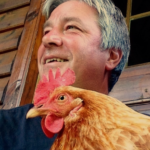
Today, I will explain how to tell if your bird is starting to enter the fascinating yet often misunderstood phase called molting. Spotting the early signs can help you understand and care for your chickens during this natural process.
The first molting stage is subtle, but staying vigilant will clue you into your bird’s condition. Birds often begin molting by losing their sheen, with their feathers looking lackluster and looser than usual. They can be a little ruffled and even look like your hair on those bad hair days, lol.
But there’s more to it than just looks. Watch their behavior. If your bird is molting, it might show more interest in preening and sometimes seem crankier than usual. Molting can be uncomfortable for them, so these manner changes aren’t surprising.
Also, you might notice changes in appetite; it may fluctuate or increase as the bird’s body demands more nutrients to make new feathers. These subtle hints can really tip you off to your bird’s molting phase before the more obvious loss of feathers begins.
If you want your birds to weather the couple of months of the molting period with as little discomfort as possible, make sure to give them some extra protein and plenty of fresh water. If you’re really nice, there are supplements that can also benefit the molt.
It’s crucial to understand not just the ‘when’ and the ‘how’ but also the ‘why.’ What exactly triggers your bird to start shedding its old plumage in preparation for the new? That will include looking at environmental factors and more, which I’ll cover in the next section.
What Makes the Feathers Fall?
What exactly triggers this process? It’s not just about the physical transformation; it’s a complex physiological response to various aspects of your bird’s environment and well-being.
Seasonal changes are primarily responsible for triggering the molt. As the days shorten, your pet’s internal clock receives the signal that it’s time to renew its feathers. This is nature’s way of ensuring that birds are at their peak condition for the upcoming cold snap of winter.
Apart from the seasons’ rhythm, a lot is happening within your bird’s body that can spur on molting. Nutrition plays a vital role. A diet lacking essential nutrients or a sudden change in eating habits can be the green light for starting the molt.
Similarly, stress, whether from environmental changes, illness, or other factors, can stimulate a molt—often resulting in what’s known as a ‘stress molt.’
A major frame of understanding is distinguishing between a standard molt and one induced by stress. While molting is a natural and healthy part of a bird’s life cycle, stress molting can signal that something isn’t quite right in your pet’s environment.
Watching for unnecessary feather plucking or an out-of-season molt can indicate that something more is afoot. A molt induced by stress highlights the need for a closer look at your bird’s living conditions and general health.
The Molting Calendar

Understanding the seasonal patterns associated with molting is crucial. For most birds, molting occurs once or twice a year, often in late summer or fall. However, the timing can vary significantly depending on the species and their natural habitat environments.
Living in captivity, where controlled temperatures and artificial lighting are the norms, can influence the natural cues your bird would normally receive in the wild. Indoor birds might experience a more spread-out molting process or have molting periods that don’t align with outdoor birds.
Location also plays a part. For instance, birds in the northern hemisphere may begin to molt as the days start getting shorter post the summer solstice. In contrast, if you live closer to the equator, molting might not be as tied to the seasons, given the more consistent daylight patterns throughout the year.
It is important to adjust your bird’s care as they molt according to the time of year. As days shorten, ensure your pet has adequate protein to maintain health and well-being. Monitoring their molting process helps you anticipate when to provide extra nutritional support, which I’ll help you with in the next section.
Helping Your Birds Through the Molting Phase
If you’ve noticed the telltale signs; feathers falling, fewer eggs laid, your bird is likely deep into the molting process, and adjustments must be made. That starts with nutrition. Birds often require additional protein and vitamins to facilitate healthy feather growth. Consider foods like boiled eggs, leafy greens, and specialized pellet diets, all of which can be beneficial.
Beyond diet, the place your bird calls home should be a haven, especially during molting. Maintain consistent routines and create a calm atmosphere to keep stress to a minimum. You might be tempted to try home remedies, but talk to your vet when in doubt. They can provide tailored advice and may recommend supplements if necessary.
Regular check-ups are more than a precaution; they invest in your bird’s well-being. A veterinarian can offer insights that are specific to your bird’s species and individual health needs. If at any point the molting seems excessive or is accompanied by concerning symptoms, don’t hesitate to reach out for professional help.
Molting is a natural process, but that doesn’t mean it’s without its challenges. It’s important to remain observant and responsive to your pet’s needs. Don’t worry too much about the mess of feathers; instead, focus on the vibrant growth to come.
Just remember that patience and attentive care will go a long way in ensuring your feathered friend emerges from the molt even more magnificent than before.
Please let me know if you have any questions.
Dave

Chickenmethod.com

